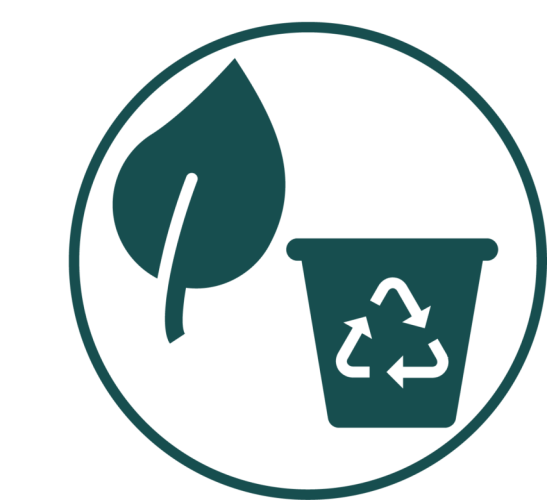Food Waste – Research Background
Food waste mainly refers to perishable domestic waste containing organic matter, including household food waste, restaurant food waste and other food waste. Household food waste is produced in residents’ daily life such as leftovers and waste food; Restaurant food waste is food residues and processing wastes generated by relevant enterprises or public institutions in food processing, catering services and other activities; Other food waste is the waste of vegetables, fruits or rotten meat produced in the farmers’ market. Food waste in China has the characteristics of high proportion of organic matter and high content of water and salt. In addition, China’s food waste accounts for a relatively high proportion of municipal solid waste. It has a large volume and is easy to rot or produce odor, which make it difficult to deal with. In recent years, China has actively promoted waste classification. Local governments have successively issued a series of waste classification policies, which has effectively promoted the classification of waste at sources and the allocation of facilities resources. The amount and rate of classified food waste have increased. The demand for food waste treatment technology and treatment facilities has also increased. The market scale has been expanding, and many different processing technology and related technology equipment suppliers have emerged. However, the industry lacks relevant evaluation systems and methods, so it is difficult to objectively evaluate these different food waste treatment technologies.
The “China Integrated Waste Management NAMA Support Project” together with the School of Environment of Tsinghua University, try to discuss and establish a technical evaluation system of food waste by case analysis.
Typical Food Waste Treatment Technology in China
In general, the main idea is harmless treatment and resource utilization, in which C, N, P, K and other elements are biotransformed and utilized, and can even be transformed into new resources with appropriate processing.
At present, China has basically formed a technical route for food waste treatment and resource utilization, which is mainly anaerobic digestion, supplemented by composting, as well as insect larvae processing method. Among the above treatment technologies, anaerobic digestion is the main technology utilized in China, accounting for 80% of the planning or constructed projects. Anaerobic digestion can be divided into dry process and wet process. Restaurant food waste with high water content and oil content is more suitable for wet process. Since household food waste has low water content and oil content, generally, the oil recovery process is not set in the treatment process. For food waste with low water content, the dry anaerobic biochemical treatment technology should be adopted. The biogas can be reused after being produced by fermentation.
However, in addition to technology selection, the construction and management quality is also related to the operation performance and environmental performance of the facilities. Existing food waste treatment projects still have some problems, such as low resource utilization rate and secondary pollution. Through scientific evaluation method, the sustainable quantification and optimal mode screening of the food waste technology combination system can be realized.
Evaluation Methodology of Food Waste Treatment Technology
To enable the evaluation of food waste treatment technologies, based on field and literature investigations, seven representative domestic technology scenarios S1 – S7 are selected as the research objects. With the application of a full life cycle analysis and by determination of the boundary range, a comprehensive evaluation system was established. The combination of the seven food waste treatment technologies is evaluated, analyzed, and ranked by different indicators. Finally, the structural evaluation model is established and the corresponding decision matrix is formulated as a tool to select the most appropriate, effective and least harmful biological treatment technology of food waste under different circumstances.
The evaluation indicators include:
- waste treatment capacity, resource utilization rate, waste residue rate;
- greenhouse and environmental pollutant emission potential;
- environmental pollution monetization;
- material conservation;
- economic benefit calculation.
And the calculation and evaluation results of key indicators are as follows:
(1) Waste treatment capacity
The waste treatment capacity is also known as waste reduction rate. It is to calculate the waste liquid and waste residue that cannot be recycled after the treatment, so as to obtain the reduction degree of treatment technology. It can reflect the rationality and effectiveness of the process.
The waste reduction rate varies greatly in different scenarios. Wet anaerobic fermentation technology is adopted in S2, S3 and S4, with high moisture content. A large amount of waste liquid will be generated in the treatment process, which needs secondary treatment, so the reduction rate is low. S6 is a biotransformation technology. The collected food waste can be directly fed to black water gadfly, thus its reduction rate is the highest. At the same time, the reduction rate will also be related to the addition of external water.
(2) Resource utilization rate
The resource utilization rate can reflect the output of products. In the process of food waste recycling, the main products include biogas, crude oil, organic fertilizer, nutrient soil, reclaimed water, biomass particles and recycled materials (plastics, glass, metal, etc.).
S6 has higher resource utilization rate. Its organic fertilizer product has large market and the highest profitability. Products of S4 are mainly soil organic acid conditioner and organic fertilizer, which have good soil improvement effects. S7 has high energy consumption and low fertilizer conversion rate. S2 and S3 only have ordinary products, basically biogas and recovery oil.
(3) Greenhouse effect reduction potential
The greenhouse effect reduction potential is to convert each greenhouse gas emission into CO2 equivalent (CO2-eq) as the characteristic index, then obtained by adding various transformed CO2-eq. Positive value represents pollution, and negative value represents the emission reduction, that is, environmental contribution.
More greenhouse gases are released in the landfill unit, and its load of greenhouse effect is significant. S7 has high energy consumption in the treatment process. What’s worse, if the product cannot be effectively utilized, there will be higher greenhouse gas emissions. In contrast, the anaerobic digestion process S2-S5 has a better reduction on the greenhouse effect.
(4) Environmental pollutant reduction potential
The environmental pollutant reduction potential is calculated based on the LCA of the solid waste system. The characteristic index is introduced to present all environmental impact results in the form of person equivalent (PE). It can realize the comparability of various environmental impact types. The environmental impact caused by the resource utilization of food waste mainly includes greenhouse effect, ozone depletion, human health risk, air pollution, acid rain, water eutrophication, etc.
S7 treatment technology has the most serious impact on the environment. The PE value of S3 and S4 environmental impact is negative, that is, the system of these scenarios can reduce the burden of environmental impact and has obvious sustainability characteristics.
(5) Environmental pollution monetization
The monetization of pollutants is to obtain the social cost of treatment by calculating the amount of polluted gas discharged in the treatment process. It can direclty reflect the environmental burden a brought by different treatment.
The smaller the pollutant emission, the greater the environmental protection potential. Composting technologies in S1 and S7 will emit relatively more polluting gases during the treatment process, which has the risk of negative impact on the environment.
(6) Economic benefits calculation
The economic benefit calculation comprehensively considers the economic benefit of the treatment plant in a certain period of time, including cost calculation and economic benefit. The cost calculation mainly includes the material and energy consumed by the operation of the treatment plant, the treatment cost of secondary pollutants, labor cost and construction cost. Economic benefits mainly include garbage collection and transportation fees and treatment subsidies, income from recycled products and materials.
The economic benefit of these scenarios is between 276.4 yuan and 685.2 yuan. The efficiency of S1 and S7 is low because the fertilizer efficiency is low and the products are not exported. In particular, S7 has large operating expenses due to its higher power consumption. S6 has the highest benefits due to its high resource utilization rate, large product market and optimistic price.
By comprehensively considering multiple indexes, the performance radar chart of each technology can be obtained, and the performance ranking of different processing technologies under each index can also be obtained. The evaluation system takes environmental performance and economy as core considerations, providing treatment evaluation and optimization suggestions for decision makers and industry participants as follows:
(1) Correlation between food waste characteristics and selection technology. For example, wet anaerobic digestion is preferred for food waste with high water content. Food waste with low water content tends to dry anaerobic digestion. If the collaborative treatment with agricultural wastes or garden wastes can be realized, with the water content less than 70%, the composting treatment method can be adopted.
(2) Correlation between resource orientation and technology selection. Considering the restriction of land use, the economy of food waste treatment mainly depends on the availability of products. For economically developed areas, land resources are limited, and the resource orientation is not significant, so it is necessary to take harmless treatment as first choice. For underdeveloped areas, such as northern areas, there may be more saline alkali land. Besides, it has rich land resources, which can promote the land improvement by utilization products.
(3) Pay attention to the construction and operation management of the project. S2/S3/S4 have similar processes and technologies, all of which are wet anaerobic digestion. However, from the perspective of energy and resource utilization efficiency, plant operation management and pollutant control, each plant may reflect obvious differences, S2 shows high environmental management requirements. S4 is special at products utilization (slurry and digestate).
(4) It is worth noting that for decentralized small-scale in-site treatment facilities, the unit energy consumption is relatively high, which means higher economic investment and greenhouse gas emissions. In addition, due to the small-scale of decentralized treatment, its environmental management and pollutant control are challenging. It can be used as an emergency treatment technology, which needs to be comprehensively evaluated by the actual situation.
(5) There is always a certain amount of impurities in each scenario of food waste treatment being sorted out and sent to the incineration plant or landfill for final disposal. In addition, if the utilization of biogas residue or organic fertilizer cannot be realized, it still needs to be sent to the incineration plant or landfill for final disposal. Therefore, for food waste treatment, high-quality classification should be gradually promoted. And aiming at final land use can reach the most typical economic and environmental benefits.

